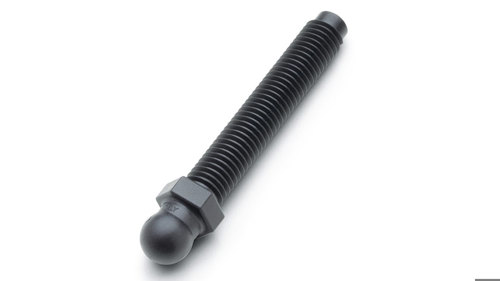The new STP threaded stems, designed for levelling equipment and machinery, are entirely made of SUPER-Technopolymer, a latest generation polymeric plastic material with high mechanical performance, excellent resistance to chemical agents, and optimum thermal properties.
Driving the development of the range is the increasingly widespread Metal-replacement phenomenon which today affects an increasing number of application sectors.
Replacing metals with engineering plastics has been possible thanks to the advent of high-performance polymers and composites which, due to their high mechanical performance and excellent temperature resistance, have allowed new uses also in applications which until now were the sole preserve of metals.

Each material has its own unique properties and is chosen based on the application, the sector, and the operating and use conditions. For this reason, the wide range of ELESA levelling elements, in addition to this latest innovation, is made up of different combinations of materials including the standard configuration with a polyamide or polypropylene based technopolymer base and stems with zinc-plated steel or AISI 304 stainless steel joint, also with no-slip disk in NBR rubber or anti-vibration disc for vibration dampening, and the numerous variants entirely made of zinc-plated steel and of different AISI classes of stainless steel, including 316L for special applications and Hygienic Design for use in environments where a certified level of hygiene is required.
Standard, but still high-performance!
The new STP stems, available in different lengths and with threads from M8 to M12, guarantee a maximum static load resistance ranging from 2700 N for the smallest sizes up to 7000 N for the largest. The surprising mechanical resistance is accompanied by the numerous advantages typical of the SUPER-technopolymer category. Let’s take a closer look at them:
- high mechanical resistance thanks to the presence of very high percentages of glass fibre bonded with appropriate chemical primers to the base polymer and/or the presence of synthetic aramid fibre;
- resistance to corrosion and to the most common chemical agents for applications that require frequent washing (food, pharmaceutical, medical, etc.) or for use in humid environments or outdoors, with excellent durability. Figure 3 compares resistance to the most common chemical agents between the SUPER-Technopolymer version and the zinc-plated steel and stainless-steel versions. As can be seen in the detailed table, there are many more black marks (Suitable) in the SUPER-Technopolymer material column;
- lightness which, in addition to making transport, storage and handling more economical, represents an advantage especially for those applications intended for mobile machines or equipment;
- a significant economic advantage compared to traditional stainless steel or zinc-plated steel solutions (Figure 4). The “y” axis shows how the range of unit costs, depending on the size, of the STP stems in SUPER-Technopolymer, for the same size of the ball joint (Ø 14), is far more cost-effective than the stainless steel stems or even the zinc-plated steel stems.














McMurtry Spéirling defies gravity using fan downforce
What a fun demonstration. I wonder if they were brave enough to be in the car when it was first turned over. Racing fan cars would be an interesting...